MERCEDES-BENZ METRIS 2020 MY20 Operator’s Manual
Manufacturer: MERCEDES-BENZ, Model Year: 2020, Model line: METRIS, Model: MERCEDES-BENZ METRIS 2020Pages: 320, PDF Size: 26.38 MB
Page 51 of 320
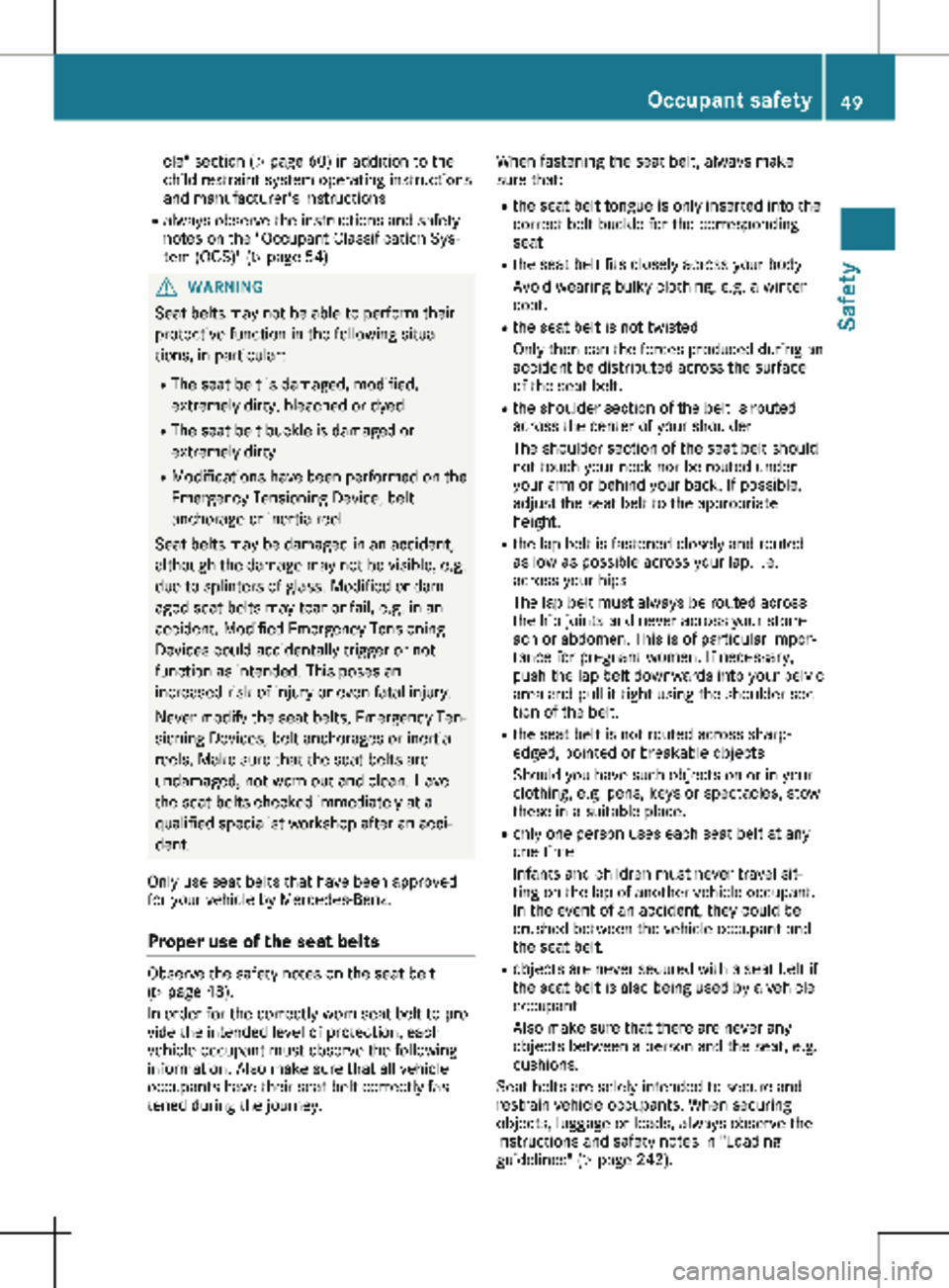
cle" section (Y page
60) in addition to the
child restraint system operating instructions
and manufacturer's instructions
R always observe the instructions and safety
notes on the "Occupant Classification Sys-
tem (OCS)" ( Y page 54)G
WARNING
Seat belts may not be able to perform their
protective function in the following situa-
tions, in particular:
R The seat belt is damaged, modified,
extremely dirty, bleached or dyed
R The seat belt buckle is damaged or
extremely dirty
R Modifications have been performed on the
Emergency Tensioning Device, belt
anchorage or inertia reel
Seat belts may be damaged in an accident,
although the damage may not be visible, e.g.
due to splinters of glass. Modified or dam-
aged seat belts may tear or fail, e.g. in an
accident. Modified Emergency Tensioning
Devices could accidentally trigger or not
function as intended. This poses an
increased risk of injury or even fatal injury.
Never modify the seat belts, Emergency Ten-
sioning Devices, belt anchorages or inertia
reels. Make sure that the seat belts are
undamaged, not worn out and clean. Have
the seat belts checked immediately at a
qualified specialist workshop after an acci-
dent.
Only use seat belts that have been approved
for your vehicle by Mercedes-Benz.
Proper use of the seat belts Observe the safety notes on the seat belt
(Y page
48).
In order for the correctly worn seat belt to pro-
vide the intended level of protection, each
vehicle occupant must observe the following
information. Also make sure that all vehicle
occupants have their seat belt correctly fas-
tened during the journey. When fastening the seat belt, always make
sure that:
R the seat belt tongue is only inserted into the
correct belt buckle for the corresponding
seat
R the seat belt fits closely across your body
Avoid wearing bulky clothing, e.g. a winter
coat.
R the seat belt is not twisted
Only then can the forces produced during an
accident be distributed across the surface
of the seat belt.
R the shoulder section of the belt is routed
across the center of your shoulder
The shoulder section of the seat belt should
not touch your neck nor be routed under
your arm or behind your back. If possible,
adjust the seat belt to the appropriate
height.
R the lap belt is fastened closely and routed
as low as possible across your lap, i.e.
across your hips
The lap belt must always be routed across
the hip joints and never across your stom-
ach or abdomen. This is of particular impor-
tance for pregnant women. If necessary,
push the lap belt downwards into your pelvic
area and pull it tight using the shoulder sec-
tion of the belt.
R the seat belt is not routed across sharp-
edged, pointed or breakable objects
Should you have such objects on or in your
clothing, e.g. pens, keys or spectacles, stow
these in a suitable place.
R only one person uses each seat belt at any
one time
Infants and children must never travel sit-
ting on the lap of another vehicle occupant.
In the event of an accident, they could be
crushed between the vehicle occupant and
the seat belt.
R objects are never secured with a seat belt if
the seat belt is also being used by a vehicle
occupant
Also make sure that there are never any
objects between a person and the seat, e.g.
cushions.
Seat belts are solely intended to secure and
restrain vehicle occupants. When securing
objects, luggage or loads, always observe the
instructions and safety notes in "Loading
guidelines"
(Y page 242). Occupant safety
49
Safety Z
Page 52 of 320
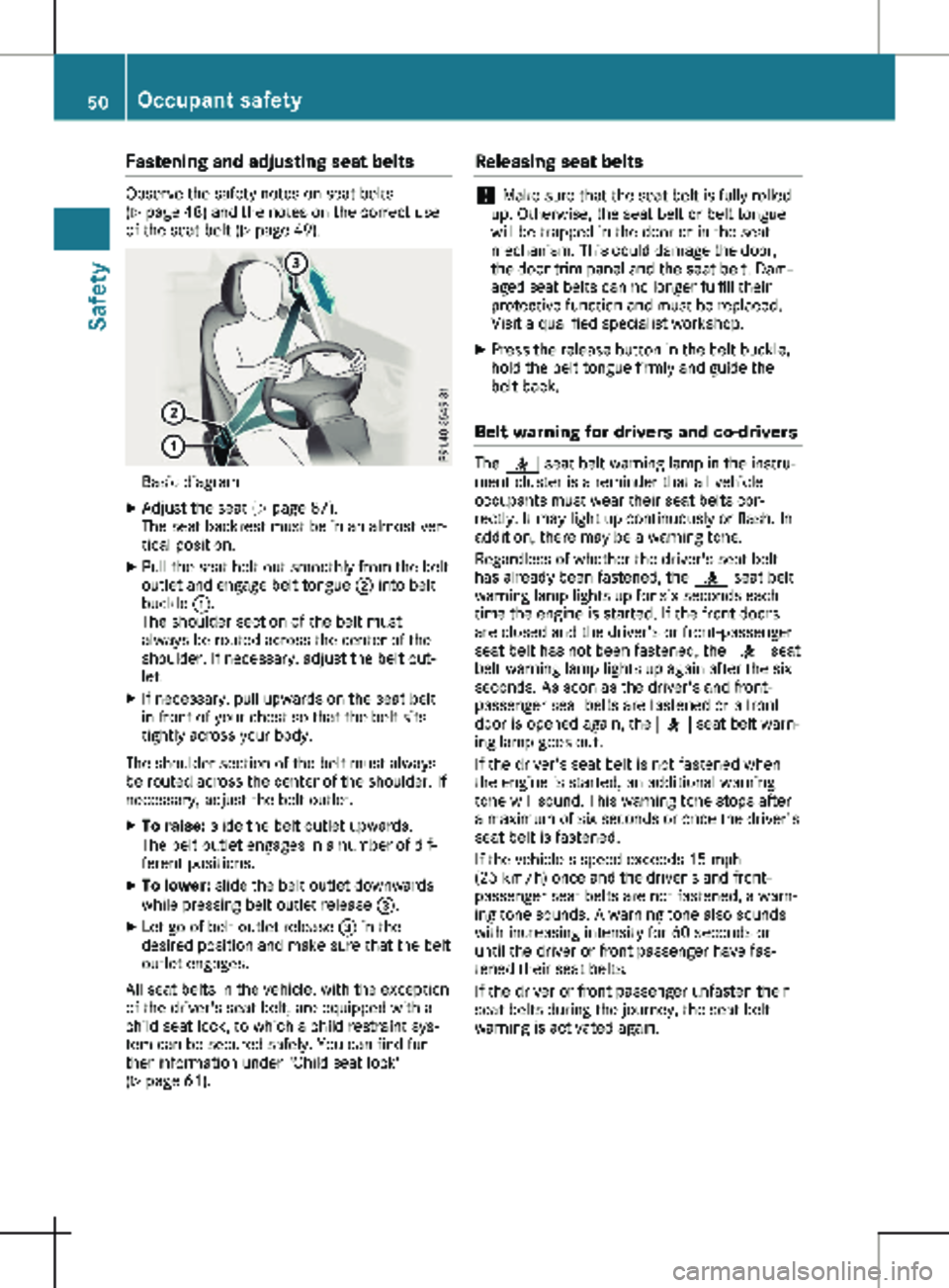
Fastening and adjusting seat belts
Observe the safety notes on seat belts
(Y page
48) and the notes on the correct use
of the seat belt (Y page 49). Basic diagram
X Adjust the seat (Y page
87).
The seat backrest must be in an almost ver-
tical position.
X Pull the seat belt out smoothly from the belt
outlet and engage belt tongue ; into belt
buckle :.
The shoulder section of the belt must
always be routed across the center of the
shoulder. If necessary, adjust the belt out-
let.
X If necessary, pull upwards on the seat belt
in front of your chest so that the belt sits
tightly across your body.
The shoulder section of the belt must always
be routed across the center of the shoulder. If
necessary, adjust the belt outlet. X To raise: slide the belt outlet upwards.
The belt outlet engages in a number of dif-
ferent positions.
X To lower: slide the belt outlet downwards
while pressing belt outlet release =.
X Let go of belt outlet release = in the
desired position and make sure that the belt
outlet engages.
All seat belts in the vehicle, with the exception
of the driver's seat belt, are equipped with a
child seat lock, to which a child restraint sys-
tem can be secured safely. You can find fur-
ther information under "Child seat lock"
(Y page
61). Releasing seat belts !
Make sure that the seat belt is fully rolled
up. Otherwise, the seat belt or belt tongue
will be trapped in the door or in the seat
mechanism. This could damage the door,
the door trim panel and the seat belt. Dam-
aged seat belts can no longer fulfill their
protective function and must be replaced.
Visit a qualified specialist workshop.
X Press the release button in the belt buckle,
hold the belt tongue firmly and guide the
belt back.
Belt warning for drivers and co-drivers The 7 seat belt warning lamp in the instru-
ment cluster is a reminder that all vehicle
occupants must wear their seat belts cor-
rectly. It may light up continuously or flash. In
addition, there may be a warning tone.
Regardless of whether the driver's seat belt
has already been fastened, the 7 seat belt
warning lamp lights up for six seconds each
time the engine is started. If the front doors
are closed and the driver's or front-passenger
seat belt has not been fastened, the 7 seat
belt warning lamp lights up again after the six
seconds. As soon as the driver's and front-
passenger seat belts are fastened or a front
door is opened again, the 7 seat belt warn-
ing lamp goes out.
If the driver's seat belt is not fastened when
the engine is started, an additional warning
tone will sound. This warning tone stops after
a maximum of six seconds or once the driver's
seat belt is fastened.
If the vehicle's speed exceeds
15 mph
(25 km/h) once and the driver's and front-
passenger seat belts are not fastened, a warn-
ing tone sounds. A warning tone also sounds
with increasing intensity for 60 seconds or
until the driver or front passenger have fas-
tened their seat belts.
If the driver or front passenger unfasten their
seat belts during the journey, the seat belt
warning is activated again. 50
Occupant safety
Safety
Page 53 of 320
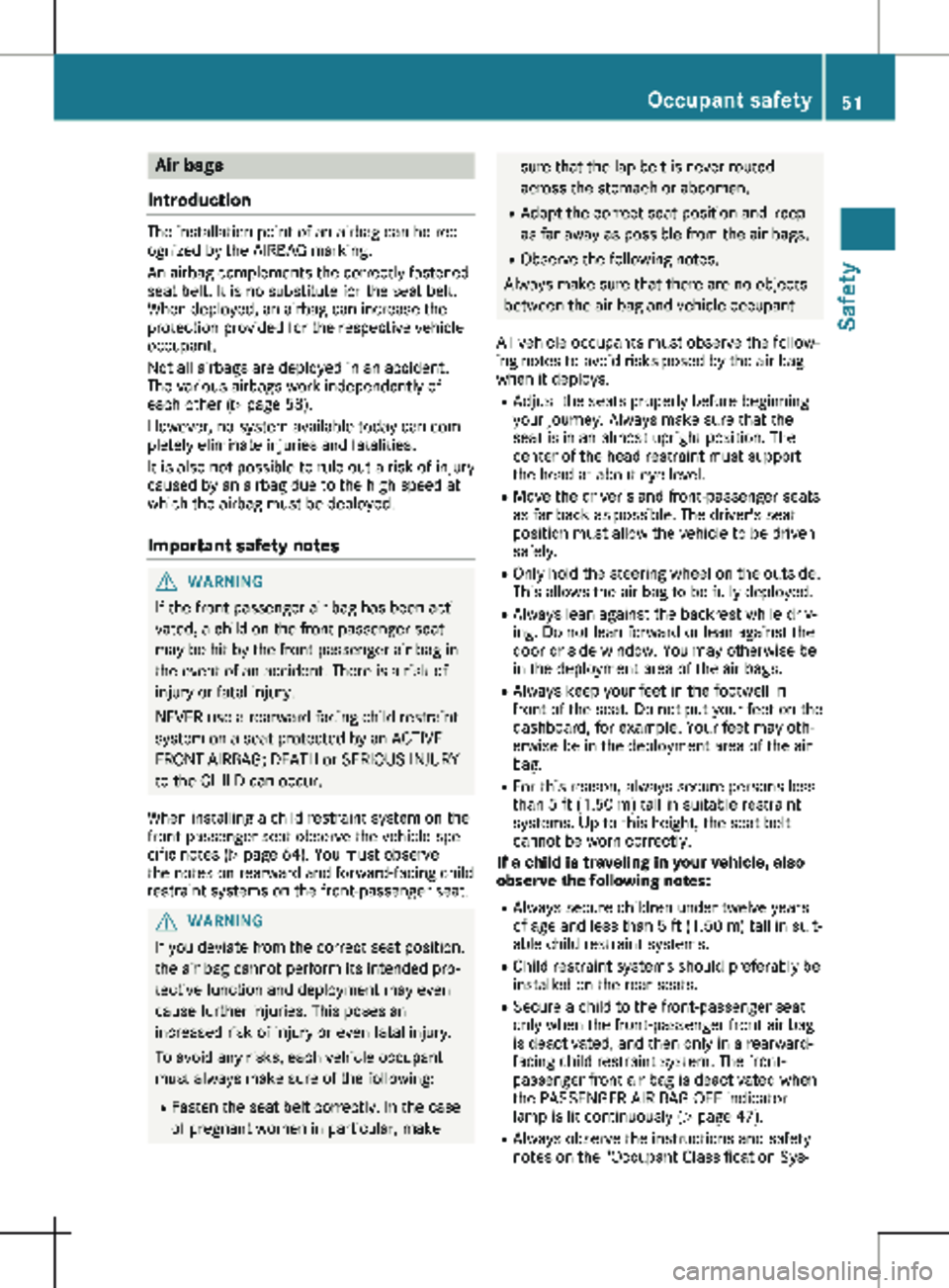
Air bags
Introduction The installation point of an airbag can be rec-
ognized by the AIRBAG marking.
An airbag complements the correctly fastened
seat belt. It is no substitute for the seat belt.
When deployed, an airbag can increase the
protection provided for the respective vehicle
occupant.
Not all airbags are deployed in an accident.
The various airbags work independently of
each other (Y page
58).
However, no system available today can com-
pletely eliminate injuries and fatalities.
It is also not possible to rule out a risk of injury
caused by an airbag due to the high speed at
which the airbag must be deployed.
Important safety notes G
WARNING
If the front passenger air bag has been acti-
vated, a child on the front passenger seat
may be hit by the front passenger air bag in
the event of an accident. There is a risk of
injury or fatal injury.
NEVER use a rearward-facing child restraint
system on a seat protected by an ACTIVE
FRONT AIRBAG; DEATH or SERIOUS INJURY
to the CHILD can occur.
When installing a child restraint system on the
front-passenger seat observe the vehicle-spe-
cific notes
(Y page 64). You must observe
the notes on rearward and forward-facing child
restraint systems on the front-passenger seat. G
WARNING
If you deviate from the correct seat position,
the air bag cannot perform its intended pro-
tective function and deployment may even
cause further injuries. This poses an
increased risk of injury or even fatal injury.
To avoid any risks, each vehicle occupant
must always make sure of the following:
R Fasten the seat belt correctly. In the case
of pregnant women in particular, make sure that the lap belt is never routed
across the stomach or abdomen.
R Adopt the correct seat position and keep
as far away as possible from the air bags.
R Observe the following notes.
Always make sure that there are no objects
between the air bag and vehicle occupant.
All vehicle occupants must observe the follow-
ing notes to avoid risks posed by the air bag
when it deploys.
R Adjust the seats properly before beginning
your journey. Always make sure that the
seat is in an almost upright position. The
center of the head restraint must support
the head at about eye level.
R Move the driver's and front-passenger seats
as far back as possible. The driver's seat
position must allow the vehicle to be driven
safely.
R Only hold the steering wheel on the outside.
This allows the air bag to be fully deployed.
R Always lean against the backrest while driv-
ing. Do not lean forward or lean against the
door or side window. You may otherwise be
in the deployment area of the air bags.
R Always keep your feet in the footwell in
front of the seat. Do not put your feet on the
dashboard, for example. Your feet may oth-
erwise be in the deployment area of the air
bag.
R For this reason, always secure persons less
than 5 ft
(1.50 m) tall in suitable restraint
systems. Up to this height, the seat belt
cannot be worn correctly.
If a child is traveling in your vehicle, also
observe the following notes:
R Always secure children under twelve years
of age and less than 5 ft (1.50 m) tall in suit-
able child restraint systems.
R Child restraint systems should preferably be
installed on the rear seats.
R Secure a child to the front-passenger seat
only when the front-passenger front air bag
is deactivated, and then only in a rearward-
facing child restraint system. The front-
passenger front air bag is deactivated when
the PASSENGER AIR BAG OFF indicator
lamp is lit continuously (Y page 47).
R Always observe the instructions and safety
notes on the "Occupant Classification Sys- Occupant safety
51
Safety Z
Page 54 of 320

tem (OCS)" (Y page
54) and on "Children
in the vehicle" ( Y page 60) in addition to
the child restraint system manufacturer's
installation and operating instructions.
Objects in the vehicle interior may restrict
the air bag from functioning correctly. To
avoid risks resulting from the speed of the air
bag as it deploys, vehicle occupants must
ensure the following points.
Before commencing your journey, ensure that:
R there are no people, animals or objects
between the vehicle occupants and an air
bag
R there are no objects between the seat, door
and B-pillar
R there are no hard objects, e.g. coat hangers,
hanging on the grab handles or coat hooks
R no accessories, such as cup holders, are
attached to the vehicle within the deploy-
ment area of an air bag, e.g. to doors or side
windows
R no heavy, sharp-edged or fragile objects are
in the pockets of your clothing. Store such
objects in a suitable place G
WARNING
If you modify the cover of an air bag or affix
objects such as stickers to it, the air bag
can no longer perform its intended function.
There is an increased risk of injury.
Never modify the cover of an air bag or affix
objects to it.
Vehicles with window curtain air bags for
all seat rows: G
WARNING
Sensors to control the air bags are located
in the doors. Modifications or work not per-
formed correctly to the doors or door panel-
ing, as well as damaged doors, can lead to
the function of the sensors being impaired.
The air bags might therefore not function
properly anymore. Consequently, the air
bags cannot protect vehicle occupants as
they are designed to do. There is an
increased risk of injury.
Never modify the doors or parts of the
doors. Always have work on the doors or door paneling carried out at a qualified spe-
cialist workshop.
Front air bags !
Do not place heavy objects on the front-
passenger seat. This could cause the sys-
tem to identify the seat as being occupied.
In the event of an accident, the restraint
systems on the front-passenger side may be
triggered and have to be replaced. The driver's air bag
: deploys in front of the
steering wheel. The co-driver's air bag ;
deploys in front of and above the glove box
and center console.
When deployed, the front air bags offer addi-
tional head and thorax protection on the front
seats.
The PASSENGER AIR BAG OFF indicator lamp
informs you about the status of the co-driver's
air bag
(Y page 47).
The co-driver's air bag will deploy only if:
R the Occupant Classification System (OCS)
has detected that the co-driver's seat is
occupied ( Y page 54). The PASSENGER
AIR BAG OFF indicator lamp is not lit
( Y page 54)
R the restraint system control unit predicts a
high accident severity
Side impact air bags G
WARNING
Unsuitable seat covers can obstruct or pre-
vent deployment of the air bags integrated
into the seats. Consequently, the air bags
cannot protect vehicle occupants as they
are designed to do. In addition, the opera- 52
Occupant safety
Safety
Page 55 of 320
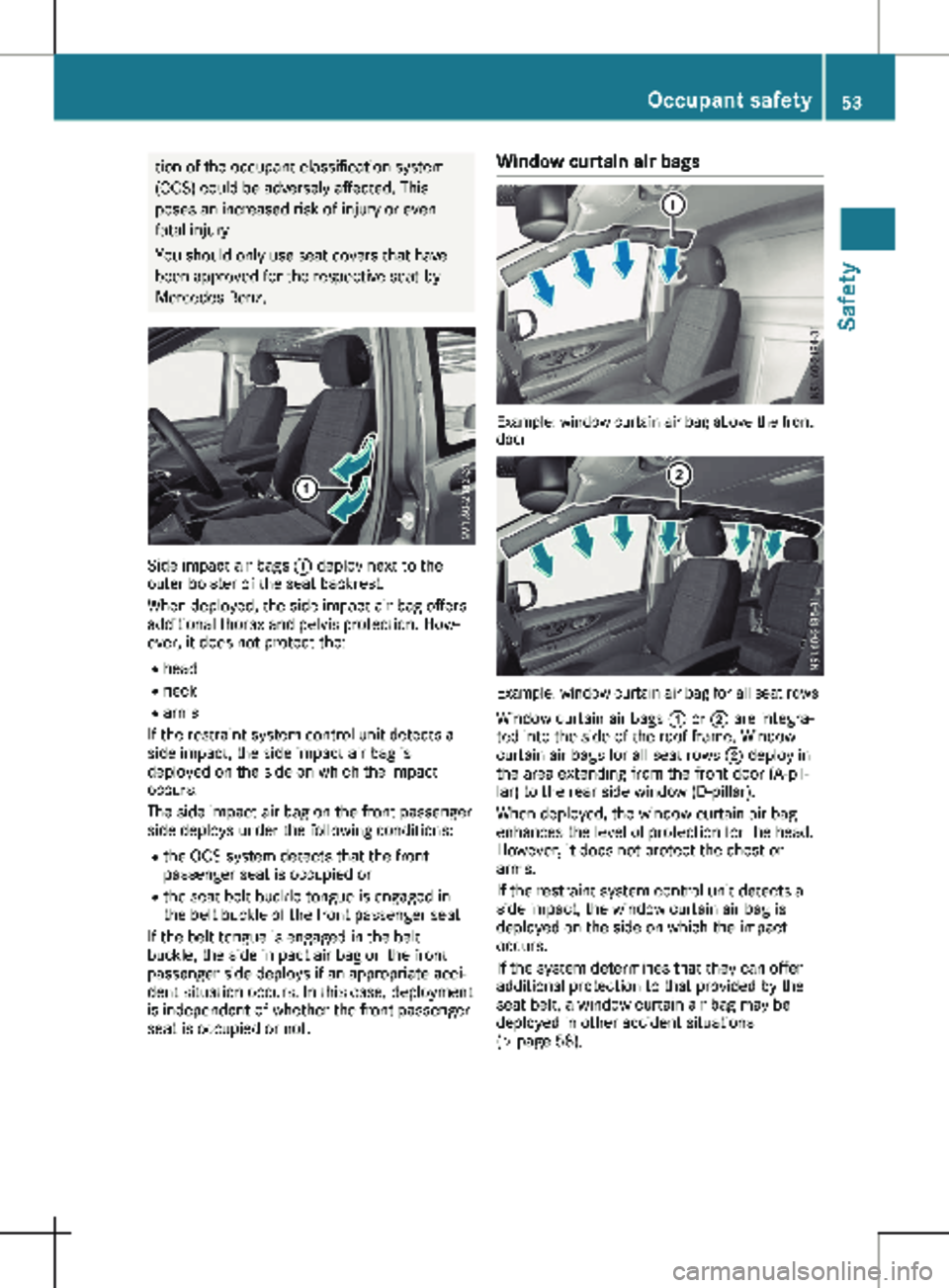
tion of the occupant classification system
(OCS) could be adversely affected. This
poses an increased risk of injury or even
fatal injury.
You should only use seat covers that have
been approved for the respective seat by
Mercedes-Benz.
Side impact air bags
: deploy next to the
outer bolster of the seat backrest.
When deployed, the side impact air bag offers
additional thorax and pelvis protection. How-
ever, it does not protect the:
R head
R neck
R arms
If the restraint system control unit detects a
side impact, the side impact air bag is
deployed on the side on which the impact
occurs.
The side impact air bag on the front passenger
side deploys under the following conditions:
R the OCS system detects that the front
passenger seat is occupied or
R the seat belt buckle tongue is engaged in
the belt buckle of the front passenger seat
If the belt tongue is engaged in the belt
buckle, the side impact air bag on the front
passenger side deploys if an appropriate acci-
dent situation occurs. In this case, deployment
is independent of whether the front passenger
seat is occupied or not. Window curtain air bags
Example: window curtain air bag above the front
door
Example: window curtain air bag for all seat rows
Window curtain air bags : or ; are integra-
ted into the side of the roof frame. Window
curtain air bags for all seat rows ; deploy in
the area extending from the front door (A-pil-
lar) to the rear side window (D-pillar).
When deployed, the window curtain air bag
enhances the level of protection for the head.
However, it does not protect the chest or
arms.
If the restraint system control unit detects a
side impact, the window curtain air bag is
deployed on the side on which the impact
occurs.
If the system determines that they can offer
additional protection to that provided by the
seat belt, a window curtain air bag may be
deployed in other accident situations
(Y page
58). Occupant safety
53
Safety Z
Page 56 of 320
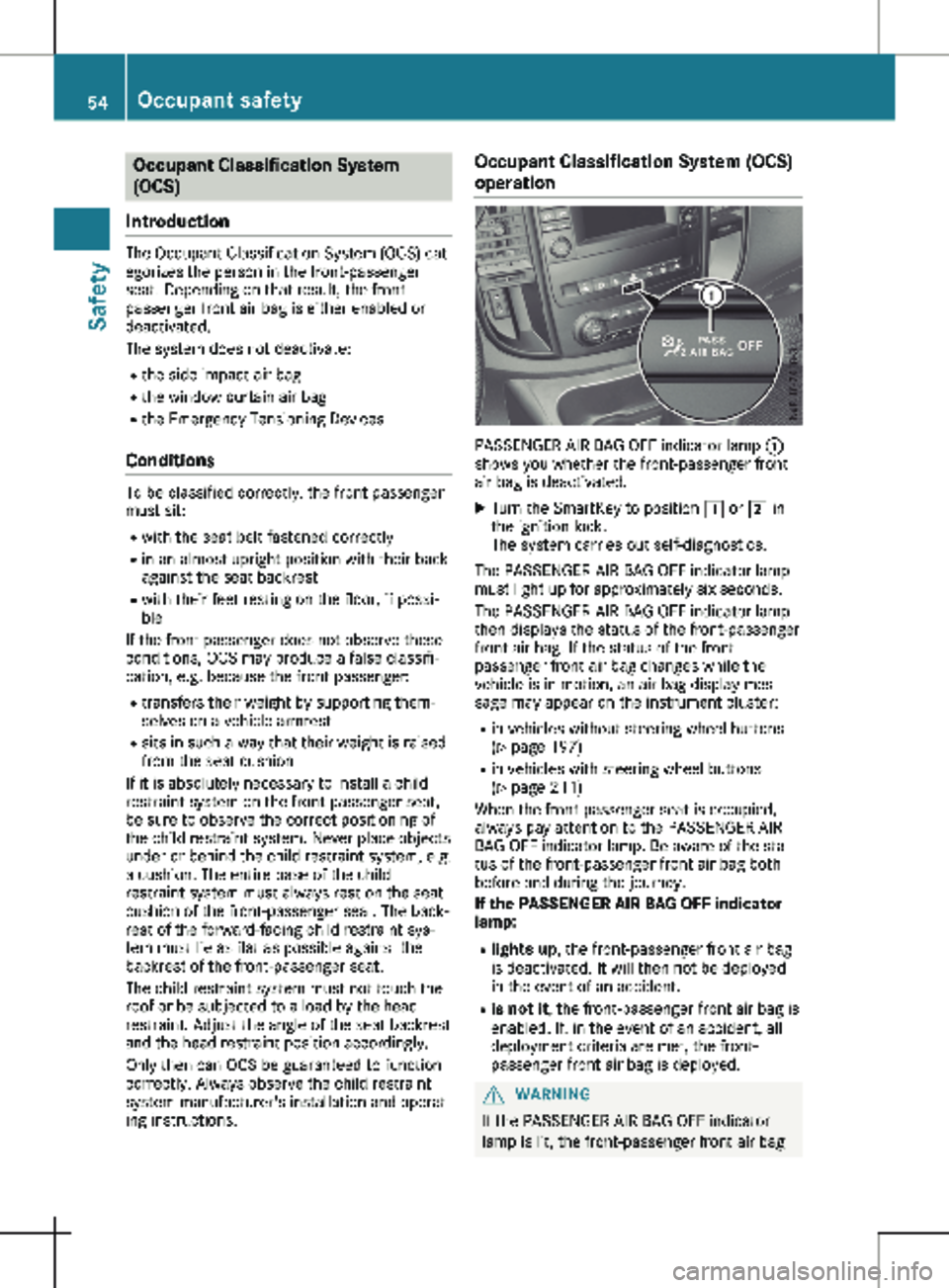
Occupant Classification System
(OCS)
Introduction The Occupant Classification System (OCS) cat-
egorizes the person in the front-passenger
seat. Depending on that result, the front-
passenger front air bag is either enabled or
deactivated.
The system does not deactivate:
R the side impact air bag
R the window curtain air bag
R the Emergency Tensioning Devices
Conditions To be classified correctly, the front passenger
must sit:
R with the seat belt fastened correctly
R in an almost upright position with their back
against the seat backrest
R with their feet resting on the floor, if possi-
ble
If the front passenger does not observe these
conditions, OCS may produce a false classifi-
cation, e.g. because the front passenger:
R transfers their weight by supporting them-
selves on a vehicle armrest
R sits in such a way that their weight is raised
from the seat cushion
If it is absolutely necessary to install a child
restraint system on the front-passenger seat,
be sure to observe the correct positioning of
the child restraint system. Never place objects
under or behind the child restraint system, e.g.
a cushion. The entire base of the child
restraint system must always rest on the seat
cushion of the front-passenger seat. The back-
rest of the forward-facing child restraint sys-
tem must lie as flat as possible against the
backrest of the front-passenger seat.
The child restraint system must not touch the
roof or be subjected to a load by the head
restraint. Adjust the angle of the seat backrest
and the head restraint position accordingly.
Only then can OCS be guaranteed to function
correctly. Always observe the child restraint
system manufacturer's installation and operat-
ing instructions. Occupant Classification System (OCS)
operation
PASSENGER AIR BAG OFF indicator lamp
:
shows you whether the front-passenger front
air bag is deactivated.
X Turn the SmartKey to position 1 or 2 in
the ignition lock.
The system carries out self-diagnostics.
The PASSENGER AIR BAG OFF indicator lamp
must light up for approximately six seconds.
The PASSENGER AIR BAG OFF indicator lamp
then displays the status of the front-passenger
front air bag. If the status of the front-
passenger front air bag changes while the
vehicle is in motion, an air bag display mes-
sage may appear on the instrument cluster: R in vehicles without steering wheel buttons
(Y page
197)
R in vehicles with steering wheel buttons
(Y page 211)
When the front-passenger seat is occupied,
always pay attention to the PASSENGER AIR
BAG OFF indicator lamp. Be aware of the sta-
tus of the front-passenger front air bag both
before and during the journey.
If the PASSENGER AIR BAG OFF indicator
lamp:
R lights up, the front-passenger front air bag
is deactivated. It will then not be deployed
in the event of an accident.
R is not it , the front-passenger front air bag is
enabled. If, in the event of an accident, all
deployment criteria are met, the front-
passenger front air bag is deployed. G
WARNING
If the PASSENGER AIR BAG OFF indicator
lamp is lit, the front-passenger front air bag 54
Occupant safety
Safety
Page 57 of 320
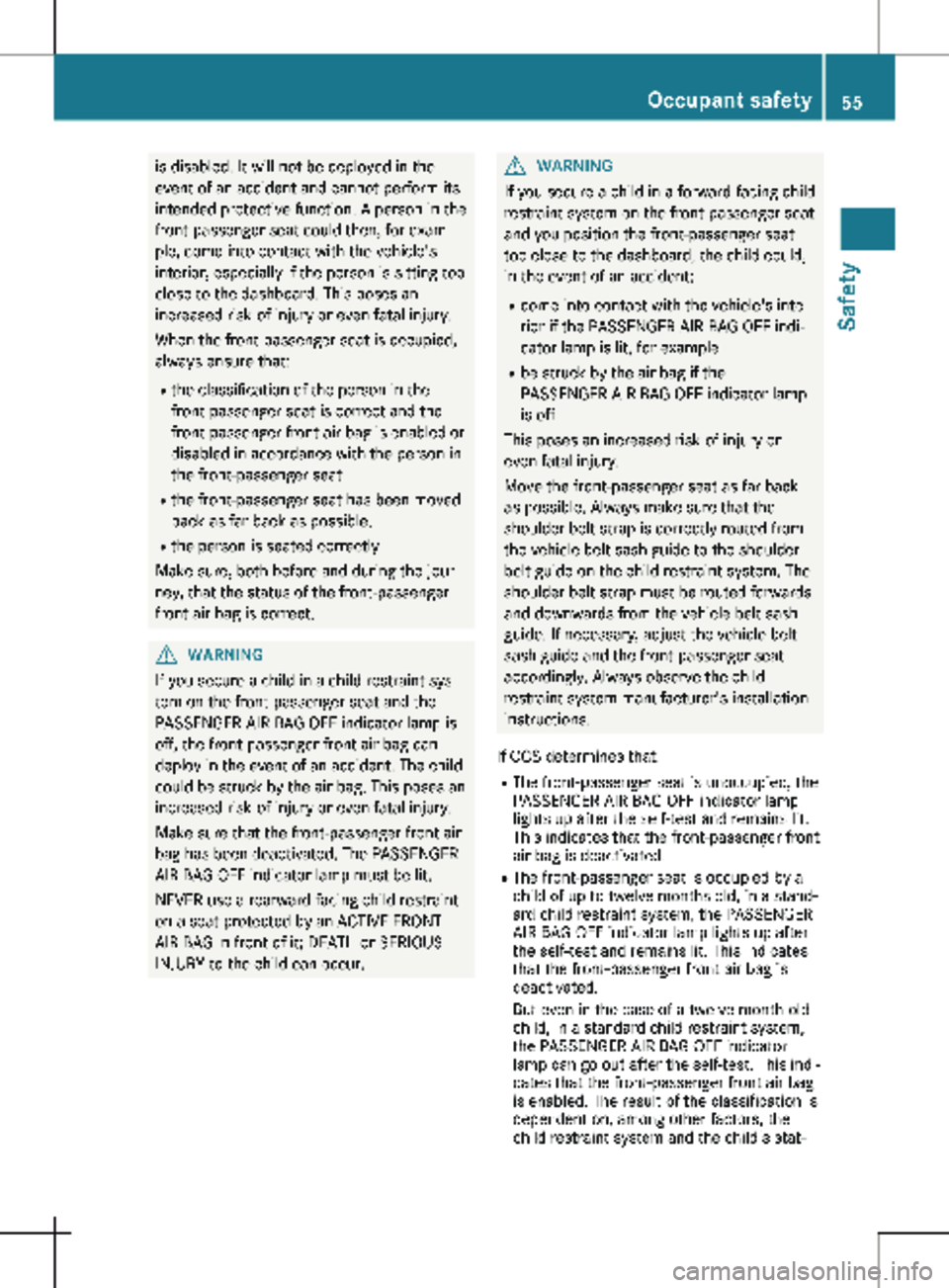
is disabled. It will not be deployed in the
event of an accident and cannot perform its
intended protective function. A person in the
front-passenger seat could then, for exam-
ple, come into contact with the vehicle's
interior, especially if the person is sitting too
close to the dashboard. This poses an
increased risk of injury or even fatal injury.
When the front-passenger seat is occupied,
always ensure that:
R the classification of the person in the
front-passenger seat is correct and the
front-passenger front air bag is enabled or
disabled in accordance with the person in
the front-passenger seat
R the front-passenger seat has been moved
back as far back as possible.
R the person is seated correctly.
Make sure, both before and during the jour-
ney, that the status of the front-passenger
front air bag is correct. G
WARNING
If you secure a child in a child restraint sys-
tem on the front-passenger seat and the
PASSENGER AIR BAG OFF indicator lamp is
off, the front-passenger front air bag can
deploy in the event of an accident. The child
could be struck by the air bag. This poses an
increased risk of injury or even fatal injury.
Make sure that the front-passenger front air
bag has been deactivated. The PASSENGER
AIR BAG OFF indicator lamp must be lit.
NEVER use a rearward-facing child restraint
on a seat protected by an ACTIVE FRONT
AIR BAG in front of it; DEATH or SERIOUS
INJURY to the child can occur. G
WARNING
If you secure a child in a forward-facing child
restraint system on the front-passenger seat
and you position the front-passenger seat
too close to the dashboard, the child could,
in the event of an accident:
R come into contact with the vehicle's inte-
rior if the PASSENGER AIR BAG OFF indi-
cator lamp is lit, for example
R be struck by the air bag if the
PASSENGER AIR BAG OFF indicator lamp
is off
This poses an increased risk of injury or
even fatal injury.
Move the front-passenger seat as far back
as possible. Always make sure that the
shoulder belt strap is correctly routed from
the vehicle belt sash guide to the shoulder
belt guide on the child restraint system. The
shoulder belt strap must be routed forwards
and downwards from the vehicle belt sash
guide. If necessary, adjust the vehicle belt
sash guide and the front-passenger seat
accordingly. Always observe the child
restraint system manufacturer's installation
instructions.
If OCS determines that:
R The front-passenger seat is unoccupied, the
PASSENGER AIR BAG OFF indicator lamp
lights up after the self-test and remains lit.
This indicates that the front-passenger front
air bag is deactivated.
R The front-passenger seat is occupied by a
child of up to twelve months old, in a stand-
ard child restraint system, the PASSENGER
AIR BAG OFF indicator lamp lights up after
the self-test and remains lit. This indicates
that the front-passenger front air bag is
deactivated.
But even in the case of a twelve-month-old
child, in a standard child restraint system,
the PASSENGER AIR BAG OFF indicator
lamp can go out after the self-test. This indi-
cates that the front-passenger front air bag
is enabled. The result of the classification is
dependent on, among other factors, the
child restraint system and the child's stat- Occupant safety
55Safety Z
Page 58 of 320
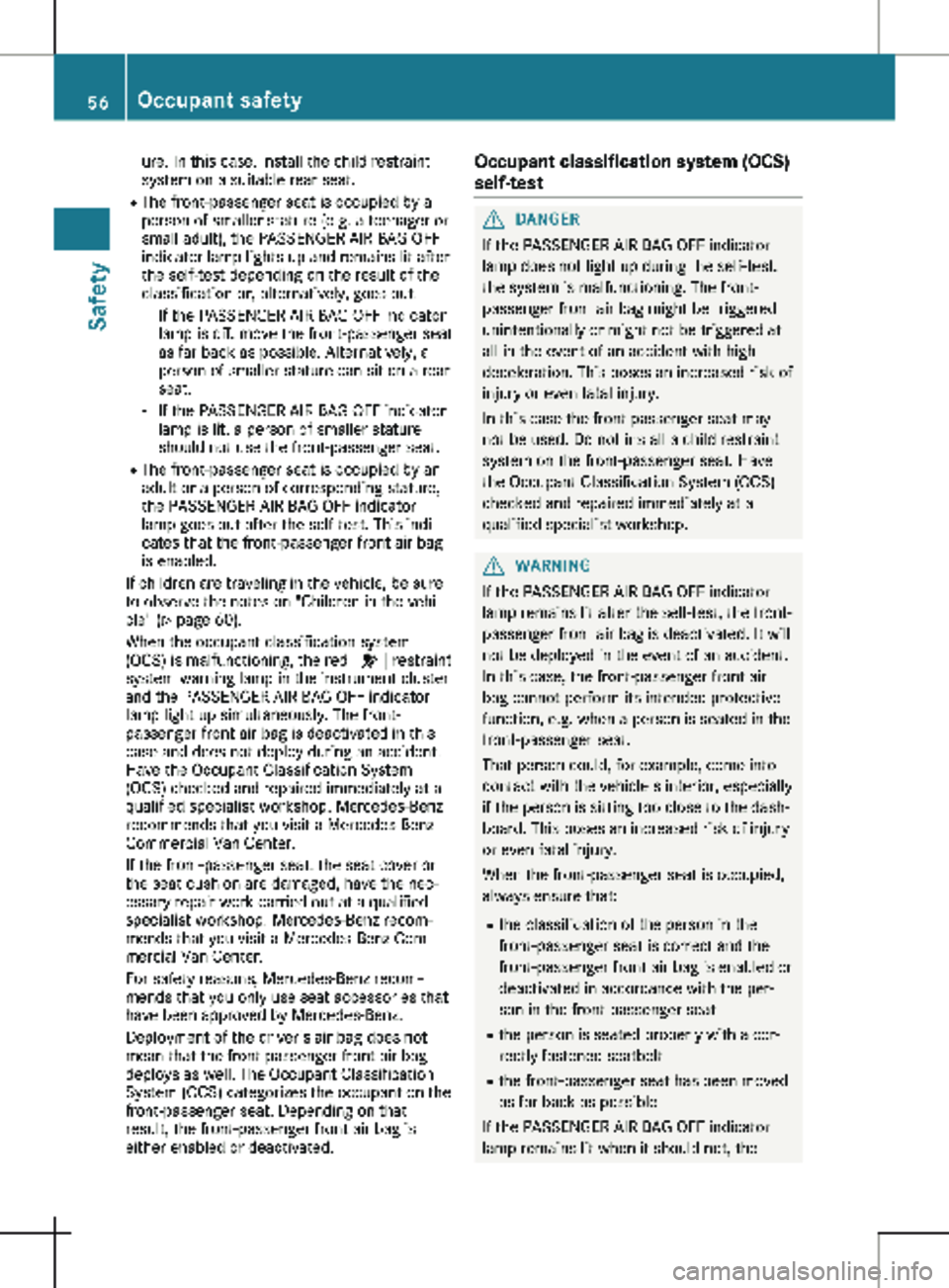
ure. In this case, install the child restraint
system on a suitable rear seat.
R The front-passenger seat is occupied by a
person of smaller stature (e.g. a teenager or
small adult), the PASSENGER AIR BAG OFF
indicator lamp lights up and remains lit after
the self-test depending on the result of the
classification or, alternatively, goes out.
- If the PASSENGER AIR BAG OFF indicator
lamp is off, move the front-passenger seat
as far back as possible. Alternatively, a
person of smaller stature can sit on a rear
seat.
- If the PASSENGER AIR BAG OFF indicator
lamp is lit, a person of smaller stature
should not use the front-passenger seat.
R The front-passenger seat is occupied by an
adult or a person of corresponding stature,
the PASSENGER AIR BAG OFF indicator
lamp goes out after the self-test. This indi-
cates that the front-passenger front air bag
is enabled.
If children are traveling in the vehicle, be sure
to observe the notes on "Children in the vehi-
cle"
(Y page 60).
When the occupant classification system
(OCS) is malfunctioning, the red 6 restraint
system warning lamp in the instrument cluster
and the PASSENGER AIR BAG OFF indicator
lamp light up simultaneously. The front-
passenger front air bag is deactivated in this
case and does not deploy during an accident.
Have the Occupant Classification System
(OCS) checked and repaired immediately at a
qualified specialist workshop. Mercedes-Benz
recommends that you visit a Mercedes-Benz
Commercial Van Center.
If the front-passenger seat, the seat cover or
the seat cushion are damaged, have the nec-
essary repair work carried out at a qualified
specialist workshop. Mercedes-Benz recom-
mends that you visit a Mercedes-Benz Com-
mercial Van Center.
For safety reasons, Mercedes-Benz recom-
mends that you only use seat accessories that
have been approved by Mercedes-Benz.
Deployment of the driver's air bag does not
mean that the front-passenger front air bag
deploys as well. The Occupant Classification
System (OCS) categorizes the occupant on the
front-passenger seat. Depending on that
result, the front-passenger front air bag is
either enabled or deactivated. Occupant classification system (OCS)
self-test G
DANGER
If the PASSENGER AIR BAG OFF indicator
lamp does not light up during the self-test,
the system is malfunctioning. The front-
passenger front air bag might be triggered
unintentionally or might not be triggered at
all in the event of an accident with high
deceleration. This poses an increased risk of
injury or even fatal injury.
In this case the front-passenger seat may
not be used. Do not install a child restraint
system on the front-passenger seat. Have
the Occupant Classification System (OCS)
checked and repaired immediately at a
qualified specialist workshop. G
WARNING
If the PASSENGER AIR BAG OFF indicator
lamp remains lit after the self-test, the front-
passenger front air bag is deactivated. It will
not be deployed in the event of an accident.
In this case, the front-passenger front air
bag cannot perform its intended protective
function, e.g. when a person is seated in the
front-passenger seat.
That person could, for example, come into
contact with the vehicle's interior, especially
if the person is sitting too close to the dash-
board. This poses an increased risk of injury
or even fatal injury.
When the front-passenger seat is occupied,
always ensure that:
R the classification of the person in the
front-passenger seat is correct and the
front-passenger front air bag is enabled or
deactivated in accordance with the per-
son in the front-passenger seat
R the person is seated properly with a cor-
rectly fastened seatbelt
R the front-passenger seat has been moved
as far back as possible
If the PASSENGER AIR BAG OFF indicator
lamp remains lit when it should not, the 56
Occupant safety
Safety
Page 59 of 320
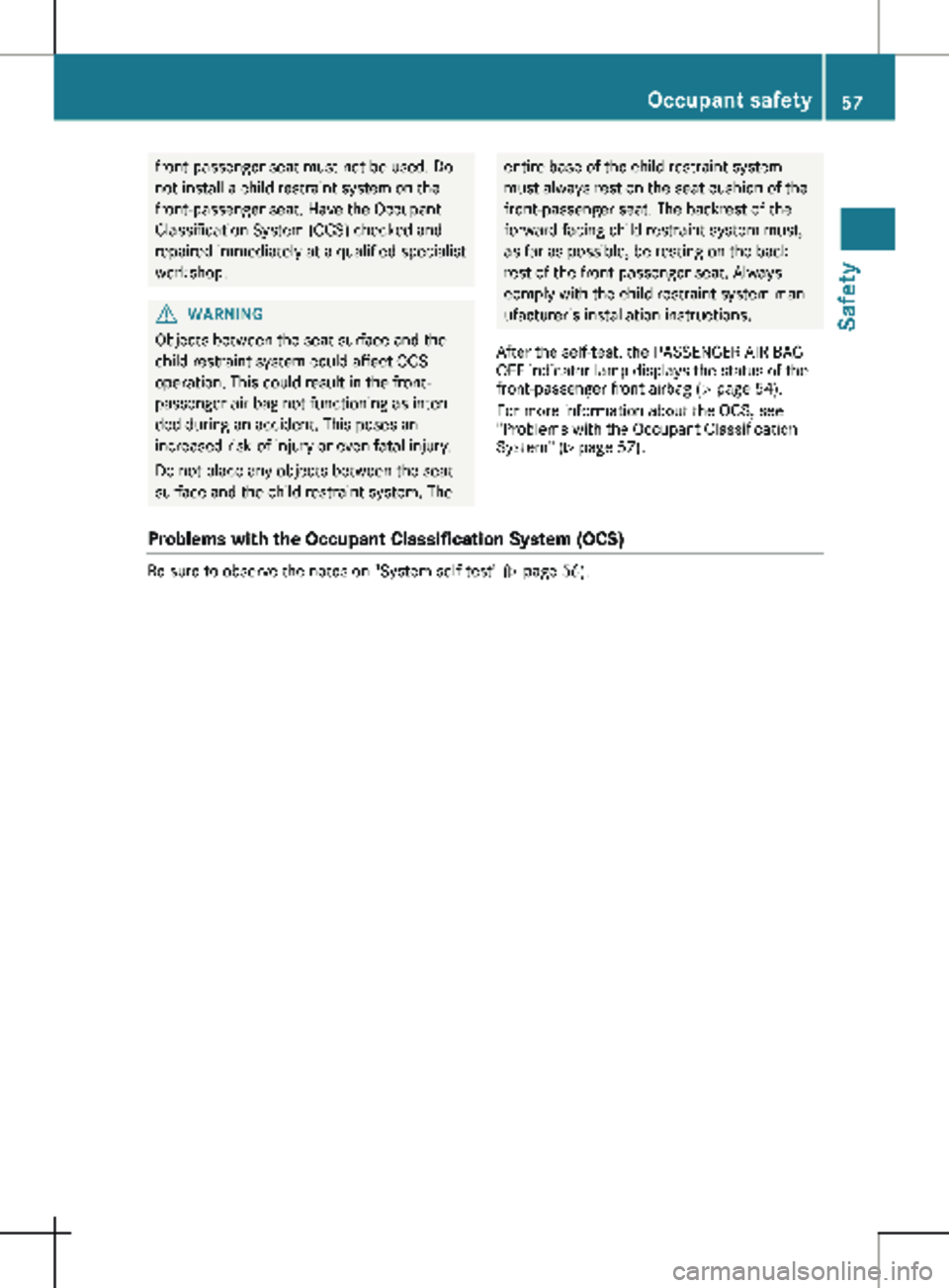
front-passenger seat must not be used. Do
not install a child restraint system on the
front-passenger seat. Have the Occupant
Classification System (OCS) checked and
repaired immediately at a qualified specialist
workshop. G
WARNING
Objects between the seat surface and the
child restraint system could affect OCS
operation. This could result in the front-
passenger air bag not functioning as inten-
ded during an accident. This poses an
increased risk of injury or even fatal injury.
Do not place any objects between the seat
surface and the child restraint system. The entire base of the child restraint system
must always rest on the seat cushion of the
front-passenger seat. The backrest of the
forward-facing child restraint system must,
as far as possible, be resting on the back-
rest of the front-passenger seat. Always
comply with the child restraint system man-
ufacturer's installation instructions.
After the self-test, the PASSENGER AIR BAG
OFF indicator lamp displays the status of the
front-passenger front airbag
(Y page 54).
For more information about the OCS, see
"Problems with the Occupant Classification
System" (Y page 57).
Problems with the Occupant Classification System (OCS) Be sure to observe the notes on "System self-test" (Y page
56). Occupant safety
57
Safety Z
Page 60 of 320
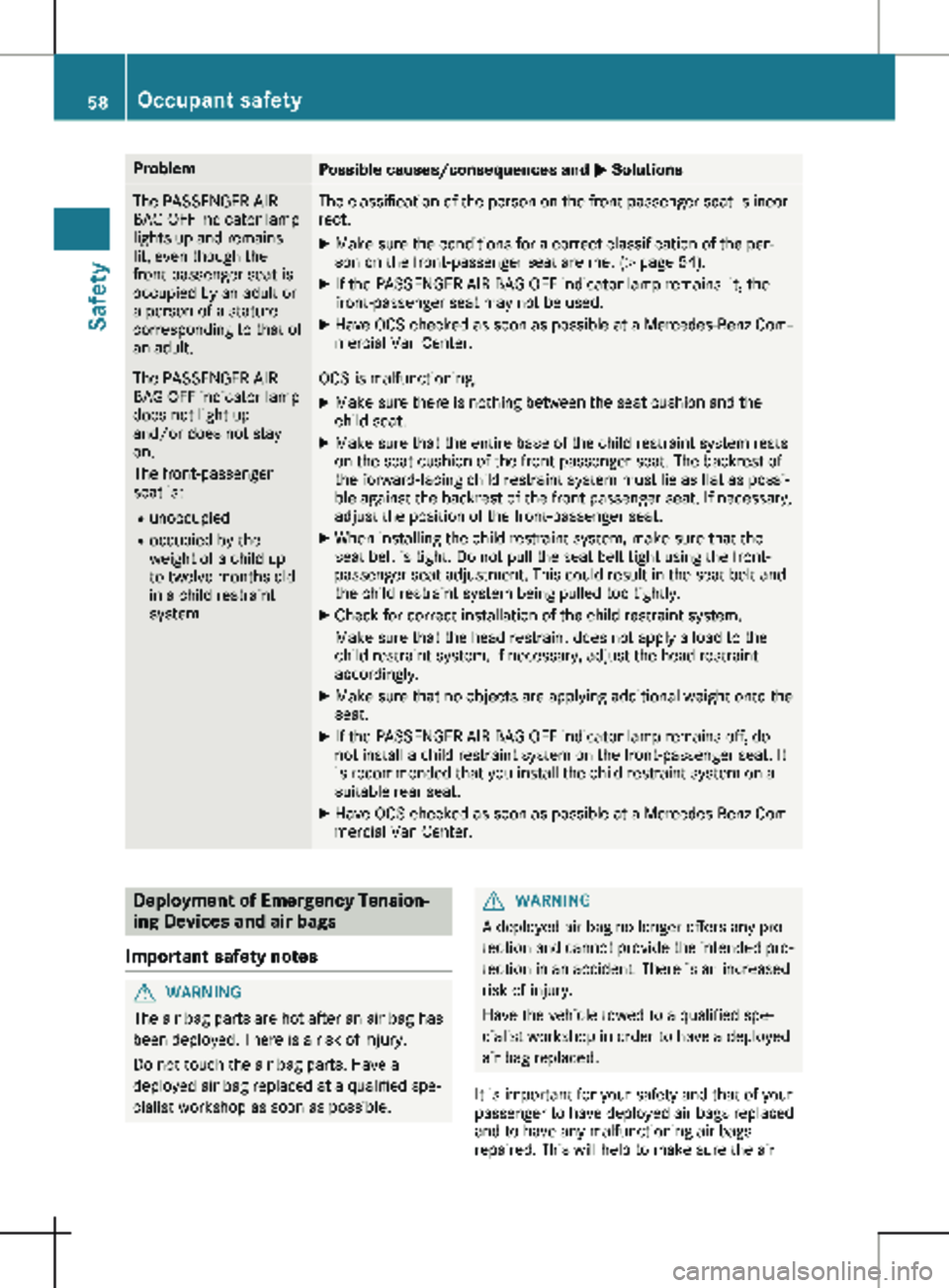
Problem
Possible causes/consequences and
M SolutionsThe PASSENGER AIR
BAG OFF indicator lamp
lights up and remains
lit, even though the
front-passenger seat is
occupied by an adult or
a person of a stature
corresponding to that of
an adult. The classification of the person on the front-passenger seat is incor-
rect.
X Make sure the conditions for a correct classification of the per-
son on the front-passenger seat are met (Y page 54).
X If the PASSENGER AIR BAG OFF indicator lamp remains lit, the
front-passenger seat may not be used.
X Have OCS checked as soon as possible at a Mercedes-Benz Com-
mercial Van Center. The PASSENGER AIR
BAG OFF indicator lamp
does not light up
and/or does not stay
on.
The front-passenger
seat is:
R
unoccupied
R occupied by the
weight of a child up
to twelve months old
in a child restraint
system OCS is malfunctioning.
X Make sure there is nothing between the seat cushion and the
child seat.
X Make sure that the entire base of the child restraint system rests
on the seat cushion of the front-passenger seat. The backrest of
the forward-facing child restraint system must lie as flat as possi-
ble against the backrest of the front passenger seat. If necessary,
adjust the position of the front-passenger seat.
X When installing the child restraint system, make sure that the
seat belt is tight. Do not pull the seat belt tight using the front-
passenger seat adjustment. This could result in the seat belt and
the child restraint system being pulled too tightly.
X Check for correct installation of the child restraint system.
Make sure that the head restraint does not apply a load to the
child restraint system. If necessary, adjust the head restraint
accordingly.
X Make sure that no objects are applying additional weight onto the
seat.
X If the PASSENGER AIR BAG OFF indicator lamp remains off, do
not install a child restraint system on the front-passenger seat. It
is recommended that you install the child restraint system on a
suitable rear seat.
X Have OCS checked as soon as possible at a Mercedes-Benz Com-
mercial Van Center. Deployment of Emergency Tension-
ing Devices and air bags
Important safety notes G
WARNING
The air bag parts are hot after an air bag has
been deployed. There is a risk of injury.
Do not touch the air bag parts. Have a
deployed air bag replaced at a qualified spe-
cialist workshop as soon as possible. G
WARNING
A deployed air bag no longer offers any pro-
tection and cannot provide the intended pro-
tection in an accident. There is an increased
risk of injury.
Have the vehicle towed to a qualified spe-
cialist workshop in order to have a deployed
air bag replaced.
It is important for your safety and that of your
passenger to have deployed air bags replaced
and to have any malfunctioning air bags
repaired. This will help to make sure the air 58
Occupant safety
Safety